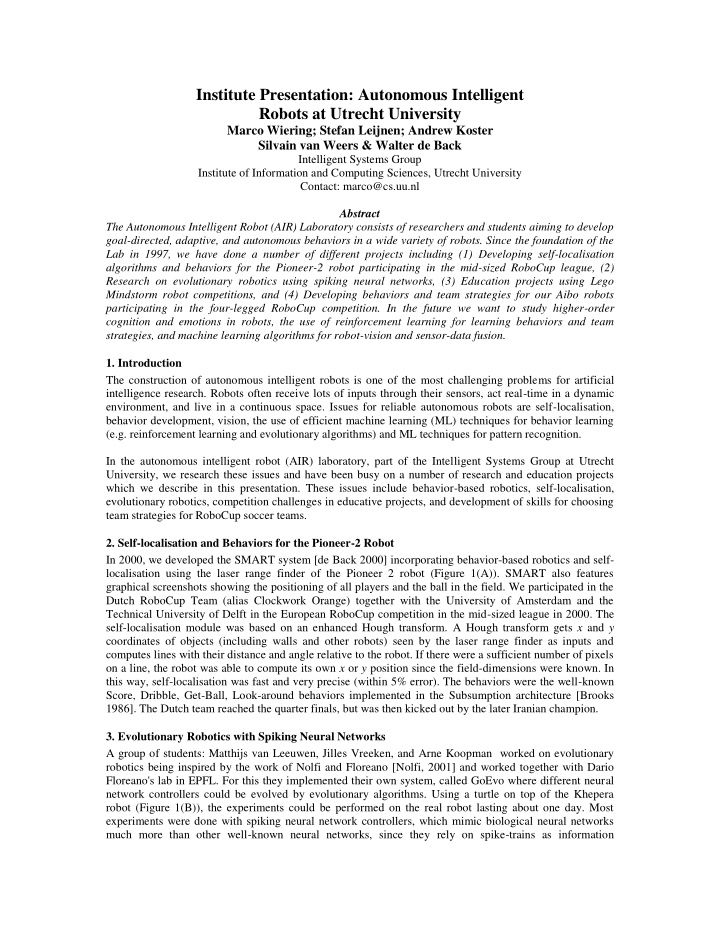



Institute Presentation: Autonomous Intelligent Robots at Utrecht University Marco Wiering; Stefan Leijnen; Andrew Koster Silvain van Weers & Walter de Back Intelligent Systems Group Institute of Information and Computing Sciences, Utrecht University Contact: marco@cs.uu.nl Abstract The Autonomous Intelligent Robot (AIR) Laboratory consists of researchers and students aiming to develop goal-directed, adaptive, and autonomous behaviors in a wide variety of robots. Since the foundation of the Lab in 1997, we have done a number of different projects including (1) Developing self-localisation algorithms and behaviors for the Pioneer-2 robot participating in the mid-sized RoboCup league, (2) Research on evolutionary robotics using spiking neural networks, (3) Education projects using Lego Mindstorm robot competitions, and (4) Developing behaviors and team strategies for our Aibo robots participating in the four-legged RoboCup competition. In the future we want to study higher-order cognition and emotions in robots, the use of reinforcement learning for learning behaviors and team strategies, and machine learning algorithms for robot-vision and sensor-data fusion. 1. Introduction The construction of autonomous intelligent robots is one of the most challenging problems for artificial intelligence research. Robots often receive lots of inputs through their sensors, act real-time in a dynamic environment, and live in a continuous space. Issues for reliable autonomous robots are self-localisation, behavior development, vision, the use of efficient machine learning (ML) techniques for behavior learning (e.g. reinforcement learning and evolutionary algorithms) and ML techniques for pattern recognition. In the autonomous intelligent robot (AIR) laboratory, part of the Intelligent Systems Group at Utrecht University, we research these issues and have been busy on a number of research and education projects which we describe in this presentation. These issues include behavior-based robotics, self-localisation, evolutionary robotics, competition challenges in educative projects, and development of skills for choosing team strategies for RoboCup soccer teams. 2. Self-localisation and Behaviors for the Pioneer-2 Robot In 2000, we developed the SMART system [de Back 2000] incorporating behavior-based robotics and self- localisation using the laser range finder of the Pioneer 2 robot (Figure 1(A)). SMART also features graphical screenshots showing the positioning of all players and the ball in the field. We participated in the Dutch RoboCup Team (alias Clockwork Orange) together with the University of Amsterdam and the Technical University of Delft in the European RoboCup competition in the mid-sized league in 2000. The self-localisation module was based on an enhanced Hough transform. A Hough transform gets x and y coordinates of objects (including walls and other robots) seen by the laser range finder as inputs and computes lines with their distance and angle relative to the robot. If there were a sufficient number of pixels on a line, the robot was able to compute its own x or y position since the field-dimensions were known. In this way, self-localisation was fast and very precise (within 5% error). The behaviors were the well-known Score, Dribble, Get-Ball, Look-around behaviors implemented in the Subsumption architecture [Brooks 1986]. The Dutch team reached the quarter finals, but was then kicked out by the later Iranian champion. 3. Evolutionary Robotics with Spiking Neural Networks A group of students: Matthijs van Leeuwen, Jilles Vreeken, and Arne Koopman worked on evolutionary robotics being inspired by the work of Nolfi and Floreano [Nolfi, 2001] and worked together with Dario Floreano's lab in EPFL. For this they implemented their own system, called GoEvo where different neural network controllers could be evolved by evolutionary algorithms. Using a turtle on top of the Khepera robot (Figure 1(B)), the experiments could be performed on the real robot lasting about one day. Most experiments were done with spiking neural network controllers, which mimic biological neural networks much more than other well-known neural networks, since they rely on spike-trains as information
propagators. For the experiments a Khepera robot with a linear camera was used. The evolutionary algorithm evolved the topology of the network. Using this set-up, experiments on collision avoidance were performed, and a number of robust controllers were evolved within 50 generations which could drive around as fast as possible without hitting the walls of the arena. Different behaviors have been evolved, some were going back and forward on a line, some were using the whole arena for driving around. Figure 1: (A) The Pioneer 2 robot, (B) The Khepera robot using spiking neural network controllers. 4. Lego Mindstorm Robot Competitions. Autonomous robotics is an interesting research area. Not only for researchers and students in autonomous or intelligent systems, but also for people interested in cognitive science, behavioral biology, and philosophy of mind. Simple robotic systems enable students from these disciplines to explore and discover new ways to view behavior and cognition through a synthetical approach. To illustrate issues in biology and robotics, the autonomous robotics course consists of three building and programming assignments, done by several groups of two or three students. These tasks promote an incremental approach, building more functionality in the robot with each assignment. First, students build a light-approaching robot, based on Braitenberg vehicle type 2a [Braitenberg, 1984]. Switching from light- approaching (type 2a) to light-avoiding (type 2b) is demonstrated by reconnecting the light-sensors. In the second assignment, students extend their first robot to include 'bump-and-go' behavior. On hitting an obstacle or wall, it backs up, turns, and continues approaching light. Apart from construction and morphological issues, this introduces the problem of action selection. To solve this, a control system is implemented based on the Subsumption architecture [Brooks, 1986].The third and final assignment takes the form of a competition in which students extend, adapt or rebuild the existing robot, building on the knowledge gained in earlier assignments. Figure 2: (A) The participants of the competition, (B) The Competition Arena
Recommend
More recommend